|
(2019
midterm assignment) Model Midterm answers 2019 (Index) Essay 1: Compare, contrast, and evaluate Narratives of the Future |
 |
Christopher Carlson
2/23/19
The Holy Trinity: An Examination
of the Three Types of Future Literature
Time is a fickle idea. While one
perception of time sees the universe with a definite beginning and end, creation
and apocalypse, others experience time as an ever-developing phenomena where the
universe adapts and responds to external stimuli by changing over multiple
millennia, the evolutionary view of time, others still show the future as a
variety of options that could ensue or exist already. Clark Omo describes the
commonality that both of these ideas have, however, when he says, “Throughout
all three of these narratives exist this fear of the unknown, and this fear is
what guides these narratives, as well as explains their purpose within the
chosen stories.” The future is an uncertain often terrifying place where
either humans’ most beautiful fantasies arise, or their darkest nightmares come
to fruition.
The creation/apocalypse narrative has
one of its hallmark portrayals within the Bible. The Creation myth sees the
inception of God’s universe. This is where mankind is bred into the garden of
Eden expected to live its days as a faithful creature to the divine. The moment
Eve partakes of the forbidden fruit is when the uncertainty and chaos of
humankind’s future arises. From the exiling of Adam and Eve was bred the
evolutionary nature of human beings, we had to modify the world around us to
stay alive. This is intriguing since creation/apocalypse are often depicted as
separate from the evolutionary, but change must occur if people are to stay
alive in such a harsh world. All things must come to an end, however, and the
Bible describes such an end as the rapture. God’s great works are brought to an
ultimate demise to return to the creator or remain in fire the rest of their
lives. The Bible presents a linear story from creation bracketing one to
apocalypse the other. God made the world, and thus he must bring about its
destruction and there is no way of altering this truth. This can be seen when
the Bible states, “And
I beheld, and, lo, in the midst of the throne and of the four beasts, and in the
midst of the elders, stood
a Lamb as
it had been slain, having seven horns and seven eyes, which are the seven
Spirits of God sent forth into
all the earth.” (Revelation, Chapter 5). The lamb is a symbolic representation
of god’s son Jesus, so his death in heaven implies that the world of the lord
will come to an end. This end is determined as being either a rebirth for the
saved or a damnation for the wicked.
This duality of apocalypses, one that brings rebirth or
one that brings about damnation, is an idea that is shown within the
Parable of the Sower. Lauren enters
the world outside her gated community much like her biblical counterparts. Many
of the people who inhabit this world see it as ended, but she feels a new world
exists among the stars. Civilized society has seemed to have been eradicated,
and thus people are either becoming more damnable or holding on to hopes of
rebuilding this barren world or another.
While Creation and Apocalypse narrative illustrate a concrete beginning
and end, this idea of a continuation after seems to show that mankind evolves
past the end to a new beginning. Interestingly, Lauren’s idea of redemption
mirrors the idea of a new Eden, when God brings his creations to live with him
in Heaven. She wants her people to seek the stars and leave behind the corrupt
world below, similar to the idea of ascending into Heaven. A relatable idea is
repeated in Revelation when the Bible states, “and the stars of the sky fell to
Earth.” (Revelation, Chapter 6).
Similar to how Lauren will find her salvation among the
heavens, they can also bring about others’ destruction, such as meteorites
hitting the planet and ending life which is what a falling star is. Lauren
wishes her converts, however, to embrace this idea of change as the almighty,
being willing to accept that nothing is finite but rather in constant flux. This
symbol is seen as almighty because it affects all aspects of the human
condition, as well as being able to affect the course of the future. This
illustrates that the idea of a new world being made must be brought about by the
end of the old, in the Bible the rapture of the old world leads to the creation
of the new world. Millennialism believes that this transition is one that could
occur at any moment, which contributes to the anxiety that is often brought
about when thinking about what the future holds. Lauren did not know when her
world would end, the gated community being demolished, but she prepared by
learning how to survive as well as developing her plan for what she would do
after. Evolutionary theory states that mankind will survive by natural
selection. Since Lauren has prepared for the new world, she will be able to
persevere. Had she not adapted, the destruction of her world would have ended in
her being damned and not saved.
Evolutionary narrative, stories
that show the universe as one that becomes more and more complex, present
mankind as learning from the situations of the past and utilizing them to
advance into the future. Stone Lives
is an excellent example of such a narrative. This future America is a world full
of technological advances, medically lengthened life and artificial body parts
to name a few. Similar technological advances are shown in the evolution of
computers in Somebody Up There Likes Me.
Computers are being made to be more and more human, with the addition of the
lips and the pain that they feel upon being destroyed, while mankind seems to
revert to more animal instincts, insulting others and harming those that are
innocent for entertainment. To return
to Stone Lives, these technological
advances are also presented alongside advancements within the business world.
Corporations have evolved into all powerful authoritative bodies that can resort
to animalistic tendencies when the need arises, they are no longer bound by
governmental restrictions on how they do business. What is interesting about
these two advances is that they are somewhat antithetical of each other. While
technology continuing to advance is showing a progressive model, the loss of
ethics and a return to primal instincts is showing a decline of standards.
Ironically, the eyes are the part that Stone has had augmented. With these
augments he sees not only the miraculous advancements of the technological
world, but the evil and corruption that exists in the human business world. Not
only are businesses losing morality bringing about this decline model, the rise
of poverty and famine is causing the lower classes to continue to delve into an
apocalyptic state. This is because the lower class are unable to evolve past the
end, since the corporations perpetually have their heels upon them. This idea of
lower classes being in a state of perpetual oppression is one of the chief ideas
mentioned within HG Wells The Time
Machine.
In the world of the remote future, mankind has literally
evolved in relationship to the class that they were bred into. As mentioned in
the previous paragraph, there will always be those that the rich push deeper and
deeper into poverty and famine, which become the Morlocks of this future world.
The Eloi evolved from the world of the aristocracy into meek beings only capable
of copulating and eating. The fact that these groups of people are actually two
distinct species illustrates that class divide will push society to a point
where they will no longer be able to mate with the other group. The Morlocks’
adaption to their darker surroundings, and the Elois’ adapting to their warmer
world is illustrating Darwinian evolution in action. The Time Traveler’s
discovery of this evolutionary trend is Wells mocking the then current classist
system. He is showing that in a world where the poor will always be trodden
upon, they will eventually develop the means to take power away from the rich,
in this by consuming the Eloi. The tenacity of the evolved lower class is what
has allowed them to revolt against those who have abused their power previously.
This is a world of decline, where mankind has transitioned into its new forms,
but has lost the ability to comprehend the complex situations and ideas of the
old world. Civilized society has literally crumbled down, as can be seen by the
number of broken and decrepit buildings that exist in this world, and the primal
beings remain, one docile and one savage-like. In this way, Wells is using
Marxist ideology to illustrate the workers revolution as the natural evolution
to the circumstances. Darwin’s theory states that the fittest survive, and that
those with the means will live on, in Marxist ideology the poor will always
strive to obtain power from the rich that have the means. What might have
happened, however, if a communistic society was implemented prior to the
division into the two species? Would the same outcome have ensued, or would a
new world of advanced humans exist? This is exactly the idea that alternative
futures attempt to answer.
An alternative world typically results from one decision
that could have ended a certain way ending differently then what was supposed to
occur. It could also be viewed as a tree, where each alterative time line
sprouts off in a different direction, like a branch, not at all altering the
time line of one when changes in the other are implemented.
Mozart in Mirrorshades is an
excellent example of this form of text. Since traveling to alternative time
lines to harvest resources has started occurring in this world, the people of
the future Earth are implementing technologies and ideas that are altering the
course of history in the old world. As people know, rock and roll did not exist
in the time period of the late seventeen hundreds. Due to the involvement of the
future, however, this world has gone through immense technological and cultural
growth, which is why Mozart has his own rock and roll band. Had the future not
been involved, the world would have progressed onward as it normally would and
resulted in a timeline identical to the one harvesting from their world. These
alterations occurring in different eras are causing mankind to rapidly evolve
the technology and culture. This notion is like rolling a dice. One does not
know where it will land, but its outcome will alter the course of a game, at one
point one will be winning and now another will be for example.
Since there is no one timeline, time is neither linear or
cyclical. It exists as a variety of histories budding off the tree and either
developing into fruition or falling under its own weight. These worlds are
abused because the future people will not be affected by their actions. Due to
the nature of time here, they can pillage, destroy, and harm as they please,
while offering advancement as a means of recompense. In essence, the future of
this alternative world might be terrifying to the people that live in the world
of the eighteenth century, but a paradise for the people that can rule over it
like kings. In this way, the future is unknown since any factor can contribute
and cause a wide variety of different paths to form. This world can be seen as
progessive in terms of its technological gains but decline in terms of its moral
ones. Going off of this idea of multiple paths going in a variety of directions,
Jorge Luis Borges examines a similar idea within his work.
Time as a maze can be seen best within the work of
Borges. When time is seen this way, it implies that there are a variety of
directions one can take, but no matter where one goes it will tremendously alter
where they will wind up. Borges illustrates this notion when Yu says, “In all
fictional works, each time a man is confronted with several alternatives, he
chooses one and eliminates the others; in the fiction of Ts’ui Pen, he
chooses-simultaneously-all of them. He creates, in this way, diverse futures,
diverse times which themselves also proliferate and fork.” In this text, Yu’
decision to kill Albert results in a chain reaction where Yu dies and the city
of Albert is destroyed. He could have just as easily hidden from the Captain or
resisted against him, while never hurting Albert. All of these scenarios would
have played out differently each one creating ripples along the water that is
time. A similar situation is seen in The
Gernsback Continuum. Had the people of previous generations pursued
differing technologies to upgrade and differing beliefs to follow, we might have
had flying cities, but under the rule of a fascist government.
This is much like the world of
The Time Machine. Had the people of
the Time Traveler’s era heeded his advice and altered their current ways, the
world of the Morlocks and Eloi might not exist at all. One change can alter the
entire course of history, in the same way that taking one path on a maze can
alter exactly where you will end up in the end. Mazes by their very nature are
terrifying. If one makes a wrong turn, you would have to retrace your steps back
to when you first erred. In this kind of reality, your one chance is the one you
live. While the others might still occur simultaneously, you will not live in
them, but be subject to the action that has led you down a certain path. In this
way, these worlds are also terrifying. If one makes the right decision, they
could be living it up with all their wildest dreams come to fruition, or the
wrong decision could result in one wallowing in their life choices feeling like
they have reached a dead end at the maze of time. This repetition of my earlier
mentioned thesis relates back to time being cyclical. It must end the same way
it begins.
As one can see, works of the future have been a unique means for we as people to address current issues in a foreign world. Their ways of explaining what the world will look like and how we will get there might differ, but the lessons they teach us about our present our usually the same. Our world is a terrifying unpredictable place. There is beauty, but also chaos, and this uncertainty can bring the greatest surprises or the most shocking ends. To better our present we must look to the future and question how we can bring about the world we want, since we do not know for sure the kind of future we inhabit. This uncertainty might be terrifying to some, but should be motivational to others to have them want to make the future what they want it to be.
 |
 |
 |
